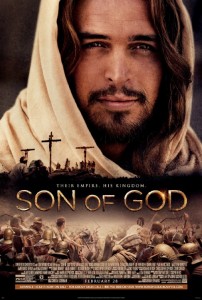** Win a copy of Son of God – see our competition below **
Son of God has been edited for cinema release around the world from the 2013 mini-series, The Bible.
The film opens with an old apostle John in exile on the Greek island of Patmos. He quotes the prologue to the gospel and what we see is a brief collage of key Old Testament stories, taken from the miniseries. At the end there is a return to Patmos and John, reflecting on his experience, sees the risen Lord and he and Jesus speak some quotations from the Book of Revelation.
The important thing about watching a Jesus film is the comparison of our memories of the texts and our imagining of particular episodes to what we see on screen. If a gospel film works well, there will be many “aha” moments when we see or hear something that has not occurred to us before. That is one of the values of seeing this film.
Some of these “aha” moments are when Jesus is interrupted by the paralysed man lowered down through the roof – and Jesus’ affectionate kiss after healing him. Again, in John 8 with the woman taken in adultery, Jesus has a stone and challenges anyone who has not sinned to take his stone to throw it. Again, when the Pharisees are denouncing the tax collectors, especially Matthew, Jesus compassionately tells the story of The Pharisee and the Publican while looking towards Matthew who begins to weep.
But most of the nuances come from the Passion narrative. When Jesus comes into Jerusalem on the donkey, the high priest actually quotes the prophecy from Zechariah, which indicates the arrival of the Messiah. Caiaphas, the High Priest wills one man to die for the sake of the nation.
The treatment of Judas is very interesting, and the screenplay shows him cautious at Jesus’ entry into Jerusalem, later persuaded by Caiaphas to bring Jesus to him. In the film Caiaphas does not indicate trial or crucifixion to Judas, though Judas is not above asking for payment for his treachery. The scene of his death is far more familiar.
The Last Supper is a quiet affair, with a strong emphasis on the bread and the cup of wine, highlighting that it represents Jesus’ own body and blood. Unfortunately, there is no washing of the feet. One interesting feature is that after Judas receives the bread and is told by Jesus to go out, he starts to choke and spits out the bread in the street.
The trials of Jesus before Annas and Caiaphas are comparatively small with few people present. However, Nicodemus is present (the same man who had been observing Jesus, going to visit Jesus and hearing him speak about being reborn). Nicodemus is present at the trials but does not vote for Jesus’ death. After Jesus death, and in the anointing and burial, he recites a prayer in Hebrew.
There has been a build-up to the presence of Pilate, a rough and ready Governor, cruel and uncaring. His wife, Claudia, is wary of the condemnation of Jesus. As in the Gospels, there is the offer of freedom for Jesus or Barabbas. Caiaphas and the priests confront Pilate and the crowd frenzy demands Jesus’ crucifixion. These sequences are well done and are particularly strong.
As Jesus goes towards his cross, he runs his hand over it and kisses it.
Jesus’ appearance near the tomb is rather fuzzy, though the hole in his hand for Thomas’s benefit is very distinctive. One of the interesting touches is that Peter, on the news of Jesus being risen, invites all those in the upper room to take the bread and wine in celebration of the resurrection. And when Peter, ashamed of his denial and thinking he could not be forgiven, sees Jesus come into the upper room, Jesus put his hand on his head in a sign of blessing and forgiveness.
Even with various limitations, this film is a sincere effort to represent the life of Jesus, and will probably make an impact on many viewers.
The full review can be found here.
 Tell us your favourite verse about Jesus. Email [email protected] with Son of God Competition in the subject line for your chance to win one of five copies of the Son of God DVD. Winners notified Friday 12 December.
Tell us your favourite verse about Jesus. Email [email protected] with Son of God Competition in the subject line for your chance to win one of five copies of the Son of God DVD. Winners notified Friday 12 December.
Email This Story
Why not send this to a friend?

